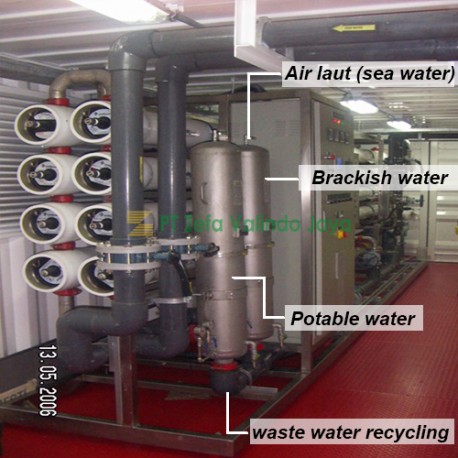No products
Prices are tax excluded
EPC - Reverse Osmosis Treatment (RO)
PLEASE FILL OUT THE SURVEY FORM HERE
Price : By Capacity
Data : By survey form
More info
PLEASE FILL OUT THE SURVEY FORM HERE
Price : By Capacity, Media type & Vessel Material
Data : By survey form
Reverse Osmosis
Under normal conditions, a liquid with a lower concentration will flow into a liquid with a high concentration.In the Reverse Osmosis (RO) system the opposite occurs, where the liquid with a high concentration is given pressure so that it can flow into the liquid with a lower concentration through the membrane layer, so that all impurities contained in the liquid will be retained in the membrane layer.
Reverse Osmosis (RO) can be defined as the process of purifying water by using a semi-permeable membrane which is under pressure to remove unwanted ions, molecules and particles that are larger in size than water.
The RO membrane has a very small density of up to 0.0001 microne so that it can withstand bacteria, viruses, dissolved salts, heavy metals, minerals and other dissolved content with sizes heavier than water molecules.
Several Reverse Osmosis applications based on their function:
1. Sea Water Reverse Osmosis (SWRO)
Used for water with high salinity or TDS, for example:
- Purification of sea water into fresh water
- Purification of brackish water into fresh water
2. Brackish Water Reverse Osmosis (BWRO)
It is used for fresh water where the TDS is not too high
- Purification of clean water into drinking water
- Recycle wastewater into clean water
3.Medical Reverse Osmosis (MRO)
Purification of water into Pure Water (pure water with a very small level of impurity) for medical purposes.
4. Reverse osmosis is also used in many production processes in various industries, for example the food and beverage industry, brewery, and so on.
EPC
The EPC depends on:
- Source of water to be treated (sea, fresh, etc.)
- Quality of water to be treated
- Processing capacity / permeate
- The target of the permeate / processed quality
Benefits of using RO
- RO is able to remove bacteria, viruses, and other solutes (TDS) including salt at once with an efficiency level of 80-99% in a very short time.
- The unit is compact and minimalist, easy to install and operate
- Easy to integrate with other water treatment units
- It is possible to recycle water, thereby reducing the cost of purchasing clean water and reducing the amount of wastewater discharged
- And others
Design
After conducting a survey and / or filling out a survey form, the PT Zefa team will design a Reverse Osmosis system according to the data from the survey or survey form.






